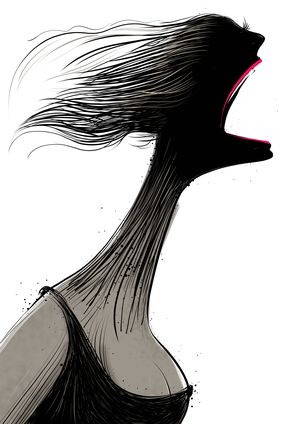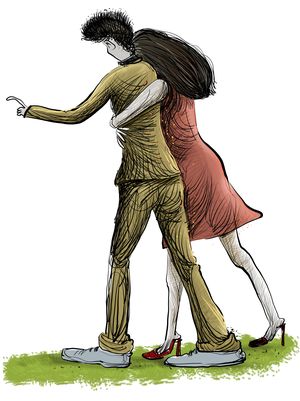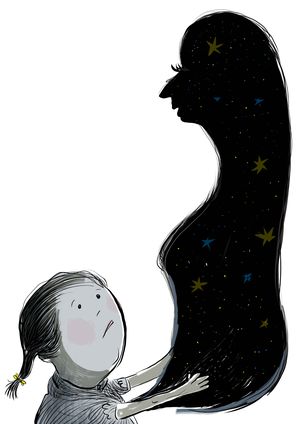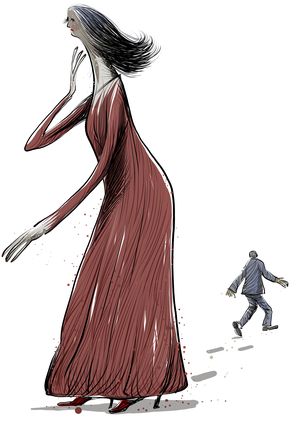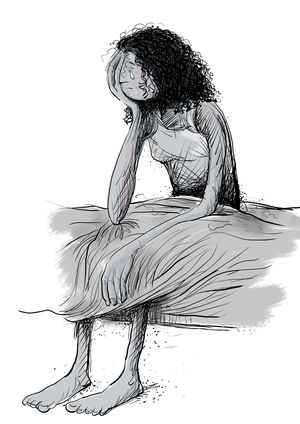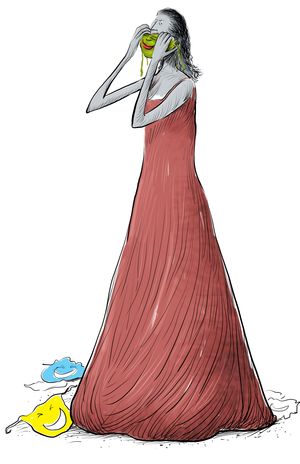Blame may not necessarily be placed on others or on external circumstance alone. Its force could be pointed towards one’s own self. The propensity to place blame within, for missed opportunities or perceived failure, acutely distresses the inner balance. It is as potent in causing disequilibrium and angst as the frustration one feels in holding others responsible for things gone wrong.
Self-blame, within a reasonable context and to a measure, may serve as a tool for reflection. However, more often than not, it breaks beyond its constructive use to indiscriminately urge the power of rage within. The mind calls itself names. These can be intense expletives and violent imaginings. It degrades itself and whips itself. Most of all, it calls itself a failure. The brain rages at this professed failure, while simultaneously pushing every system to perform and counter the notion of having flopped. A sense of urgency pervades the mind and psyche. Impatience heightens.
The contradiction is immense—one part is stuck in anger-blame, another pushes desperately to move on to disprove the belief of having failed. The image is akin to having a leash around one’s own neck, tightly held in one hand, while the other hand wields a whip and flogs one, in a desperate bid to move on to negate failure.
Vital energy, overwhelmed with anger-blame, is expended on the fight within. The body, injured and compromised by the effect of anger, is pushed further by this sense of urgency and impatience. The act of eating is also ridden with impatience. Such induced compulsion and despair stresses and strains the body and its systems to deplete resources and reserves. Fatigue sets in and the will to engage outwardly is repressed. The outcome, commonly, is depression.
Pico was 23 when she fell in love for the first time with a senior at work. A few years older than her, the man was well- travelled, well-spoken and attractive. His career was poised to take off and he had the attention of everyone around him. Pico was besotted and the man found that endearing. They saw each other for a while, and were talked about as a handsome couple. Then he moved on, unexpectedly, leaving her bereft.
On the rebound, she began to date a man who had pursued her, instead. He was younger and indulged by a rich father. He showered her with attention, and smothered her with presents. He took her around, and was always by her side. Vulnerable and unsure, she gave in to him.
The young man was high strung and in constant need of stimulation. Initially, the excitement and flux he sought worked for her. It distracted her from the grief she bore from before. But as his amusement took more intense forms, she began to feel exhausted. Her upbringing had been modest. Simplicity, routine and ethics were emphasized at home, all through her growing- up years. This new world was alien to her—the talk, the attire, the manner, the hours and the substances—all of it challenged her comfort and her roots. Yet, she stayed with it, for a while, in her defiance to prove herself a woman of the world. She’d felt betrayed by her naiveté in her previous relationship; this time, she was determined to break out of that image.
However, within the year, she felt emotionally conflicted and spent in energy. As she began to withdraw, her boyfriend expressed his disappointment in verbal abuse and once, in physical assault. It shocked her. He apologized quickly and profusely and professed his love for her. Confused, she let it pass. The next time, though, when he threatened to raise his hand, she found her voice and shouted him down. He cowered, and suddenly she saw him as a weak, fearful boy, spoilt and dependent on the whimsical largesse of his father. He hadn’t worked a day in his life and was incapable of respecting anyone else’s work or the processes that build character. She couldn’t believe she had been with him for almost a year. She knew she had to leave.
Back at work, Pico expected a few months of focus to put her on track. Work was busy and she had little time to think of anything else. But as the year wore on, she felt more unsettled than before. Something within was gnawing at her. She began to snap at her parents every time she spoke with them. This was unlike her. She knew it and they noticed it. Her mother enquired if something was amiss. It’s hectic at work and I’m tired, she’d reply, each time her parents expressed concern. At work, she increasingly felt disengaged, internally. A stance of reluctance seemed to engulf her. Her actions were ahead of her awareness of them. She went out with friends and partied hard, but felt no pleasure. Her spirits dipped; her fatigue grew. One morning, she awoke without the will to get out of bed. Her mother called as was customary, and instead of the usual exchange, Pico sobbed uncontrollably into the phone. She said she did not wish to do anything, any more.
The therapist Pico’s parents took her to, diagnosed depression. Counselling revealed a mound of unprocessed emotions. There was anger from her first relationship. She had been in love and had felt betrayed by her boyfriend’s sudden and casual change of mind. She still grieved his absence and more, she couldn’t deal with his abandoning her. It had shaken her confidence. Her inherent softness and positivity had been disregarded, and she felt she couldn’t trust what life might bring her.
That mistrust congealed with her second relationship. The fact that she’d been with someone she could never have respected, affected her own sense of worth. She felt a loss of dignity, which was heightened by the thought that she’d partaken of his world. She hated herself for it. Her experience the second time, so removed from her own leanings and preferences, left her mistrusting of her own self. It was something she would’ve liked to change but couldn’t, and it had cost her her respect, she thought. She blamed herself constantly for being so mindless about it. Her anger at herself burnt beyond what she’d known it to be. The cocktail—of anger, self-blame, hate and hurt—kept her stuck around a whirlpool of despair.
The power of anger is immense, but it asks for transformation—into resolve—for affecting change through thought or action. Blame can get in the way of transformation. Blame is the glue on which anger sticks. Dark and trolling, it can pull in all of one’s attention and consume one’s inner resource.
While stuck in blame, anger, with all its energy and momentum, drives us around the edge of a whirlpool—raging, but in loops and circles, to cause significant emotional volatility.
C C C C C C
Telly was eight when her mother died. Her father, ill-equipped and unable to devote time, left her in the care of his extended family. It was a house filled with uncles, aunts and cousins. Telly had no siblings and though her relatives were well-meaning, the girl felt daunted and isolated in this bustling home. There was speculation, too, on how and why her mother had died. She overheard the word ‘suicide’ a couple of times, and then her aunts would hush up as soon as they would spot the child.
Ill at ease and starved for attention, the girl began to play pranks that were beyond innocent ones. She wrung the neck of a cousin’s parrot. She tore another’s notebook before an examination. She mixed ditch water in the food. She poked the point of a pencil into the arm of an infant cousin. It was her way of demanding attention.
Whenever she was confronted, she would lie, to save herself from the consequences of her actions. A sympathetic aunt or two would explain to the child not to create such trouble, but the girl thrived on the initial thrill it gave her, a sense of quiet power, this ability to create trouble and command notice.
The more she lied to save herself from punishment of any kind, the more she believed her lies were true. Tired of not being able to reason with the child, the family members left her increasingly to herself. She became more alone. From deep want of a parent, she would idolize her father, who when present, would sexually abuse her.
Confused and profoundly conflicted, Telly grew into a young woman with an excessive hatred and resentment for people who were leading positive, happy lives. One part of her desperately wanted their attention; another part wanted to hurt them.
One moment she sought to endear herself to them; another moment she would trash them. Unusually bright, but coupled with a deep sense of resentment, her mind began to pull at its extremes. She would profess great interest, kindness and inclusivity, but could swing to being abusive and violent within the course of an hour. Two people seemed to dwell in her. Either one of the two could show up at an instant. For anyone in her presence, it was exhausting. As a teenager, she was unable to retain friends. Her three marriages failed. She lied compulsively, creating serious misunderstandings between family members wherever a harmonious relationship existed. She felt the urge for something dramatic to happen, and when things were peaceful, she would stir up trouble. When confronted, she displayed no concept of reasonability. In two of her marriages, she instigated legal cases against her husband and his relatives, accusing them of mistreating her. Eager to rid themselves of her and her confounding behavioural patterns, the men would pay to settle the matter and get a divorce. This became a pattern, but Telly was in denial. She was unwilling to accept her role as perpetrator. She showed no remorse for her actions, and rejected the idea that she was responsible in any way. She visualized her own reasons for her pushes and pulls, and then would believe her reasons were true, honest and justified. I’m the victim, she told herself and anyone who cared to listen.
She, too, was a victim of an abhorrent childhood. Her mother’s death left her abandoned; her father left her abused.
She denied this abuse, coercing her mind instead to invent explanations both for her father’s behaviour and for how it was making her feel within. Her imaginings impinged on all reality and obliterated facts. Reality, imaginings, hurt and desire became indistinguishable. She felt wronged, and she found others to blame, anyone but her father. She projected her victimization on acquaintances, or on random others within her zone of influence at any given point in time.
Her resistance to one expression of her psyche was so complete, that she couldn’t see any of it. It was blocked to conscious reckoning.
Resistance, in any measure, interferes with the emotional narrative. Layered over time, it obstructs mental processes, and, when in excess, it may split the psyche. It hinders the fluid functioning of various organ systems in the body. Bodily interruptions loop back signals of distress to the brain. The immune system may answer with an inflammatory response to create blockages, and further, disruption and even disorder.
Any kind of force, to break through, is pointless; force creates more resistance as a counter. Evidently, then, the probable routes to hinge the mind and psyche to stability would lie in approaches that have the power to dissolve such resistance.
C C C C C C
Anger, for instance, is known for its destructive power. In one particular Buddhist tradition, anger is considered pure energy. To that effect, I once witnessed a hen chase a cat, three times her size, across a sprawling compound, because it tried to get at one of her chicks. She ran after it, squawking and screaming with such ferocity, that the cat darted 50 metres and out of the gate. The energy of anger is thus sharp and concentrated. How we express it though is of importance. In moments of real threat to life or safety, revealed in its raw force, it strengthens us momentarily to push back the threat or to flee from it. At other moments, however, it asks for transformation, which is possible when we become aware of anger as it arises. Simply watching it spark, when it does, creates space between the emotion and its expression. In that space and instant itself, it is partially transformed. It no longer wields the same control over us. We free ourselves from its impulsive grasp and can now decide to put it to use, the way we wish to. The more and longer we watch our anger, the more aware we become of it and the greater our ability to choose how to use its energy. Significant movements—individual, social and political—have often been sparked by anger, but have sustained themselves on its transformed energy aspiring, not for violent destruction, but rather for positive change.
Anger, therefore, needn’t be suppressed. It needs to be processed, instead, so that its expression takes such form for it to not feed or create more anger around. To be ruled by anger and to run our work and lives on it, is like ‘running our car on bad fuel’, says Jaggi Vasudev . ‘You make things move ahead, but the car leaves behind a terrible black smoke that impacts everyone around negatively.’
EXCERPTED WITH PERMISSION FROM RUPA PUBLICATIONS.
Hinge: (Re)discovering Emotional and Mental Wellness
By Vandana Kohli
Published by Rupa Publications
Price Rs195; pages 244

